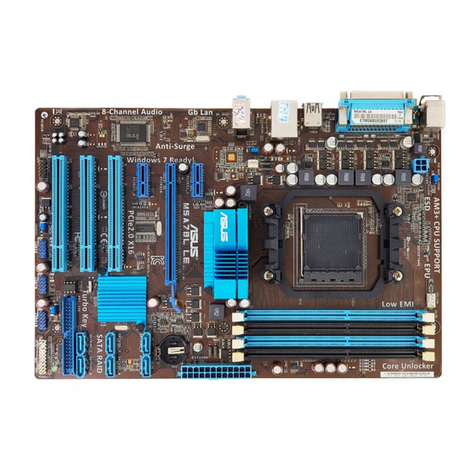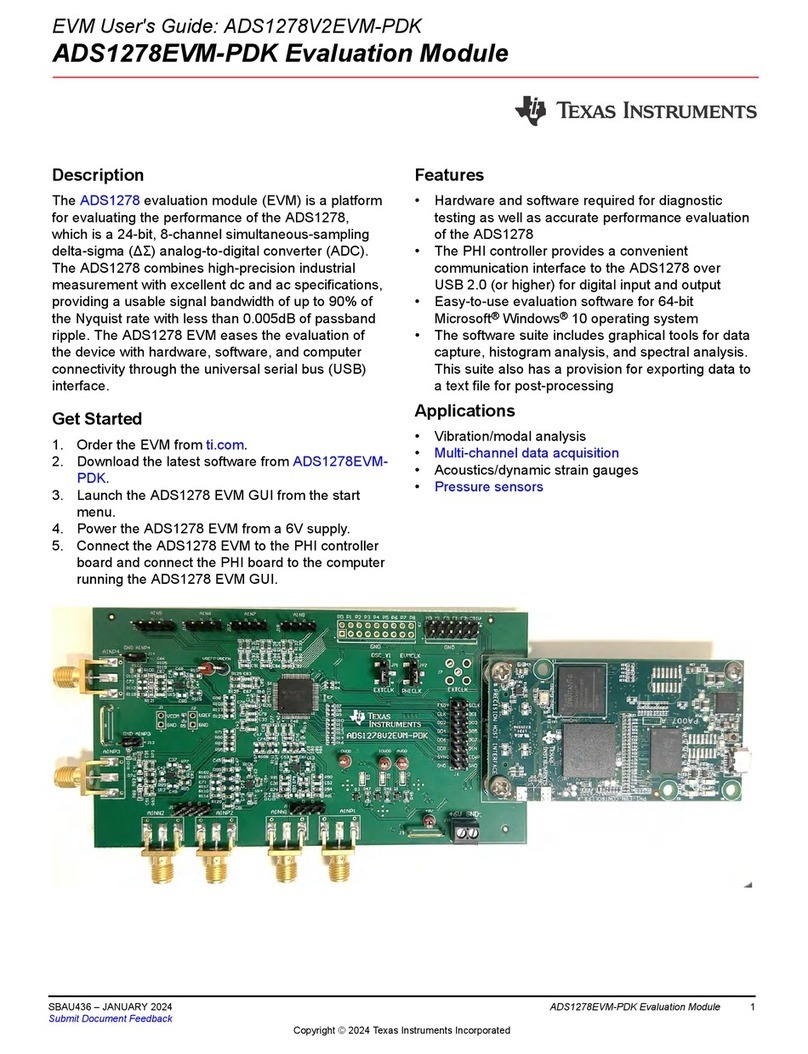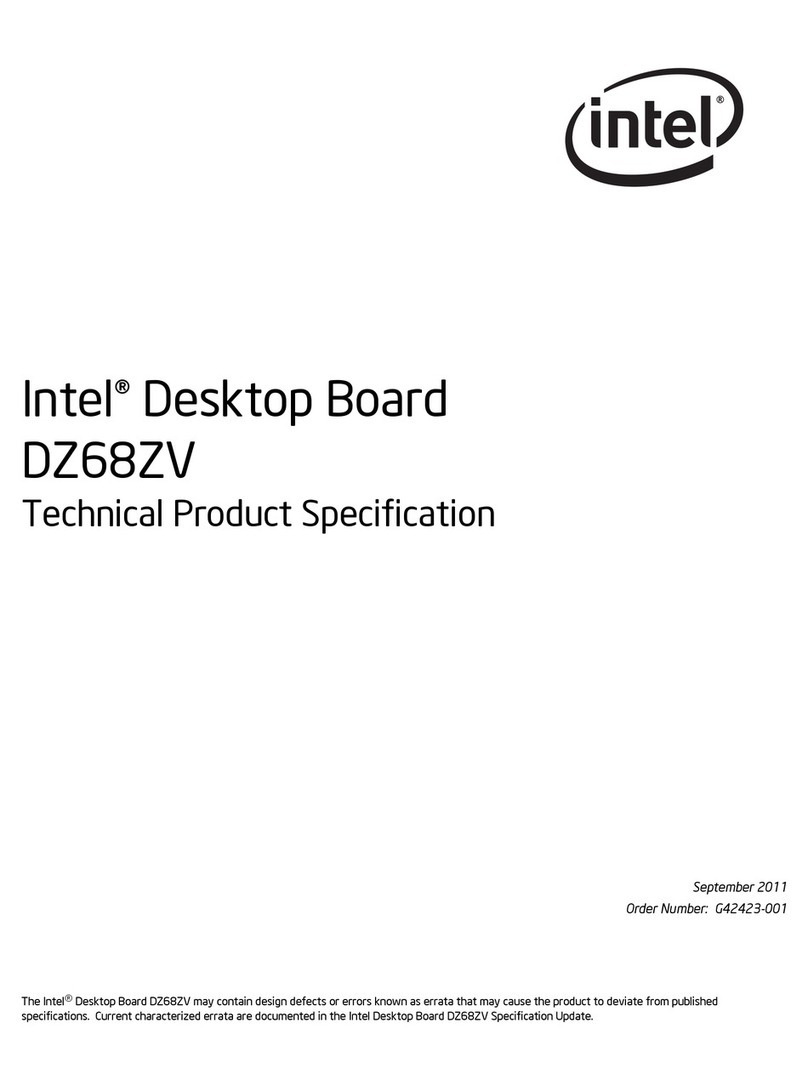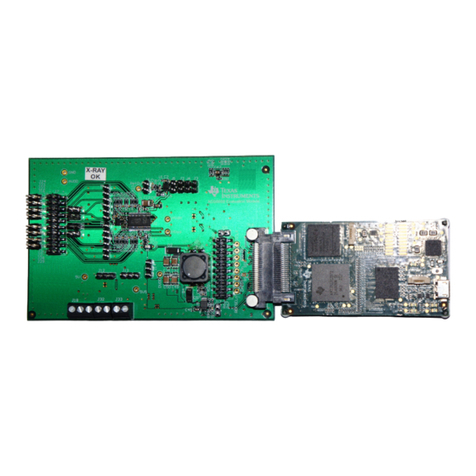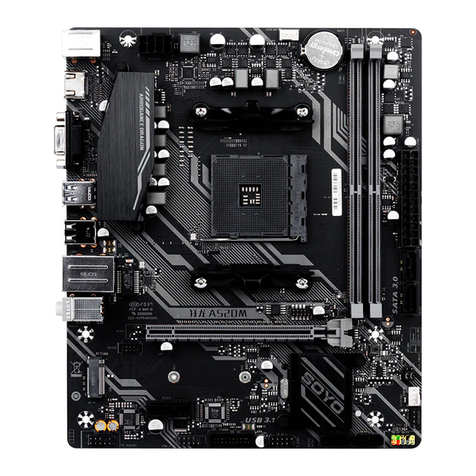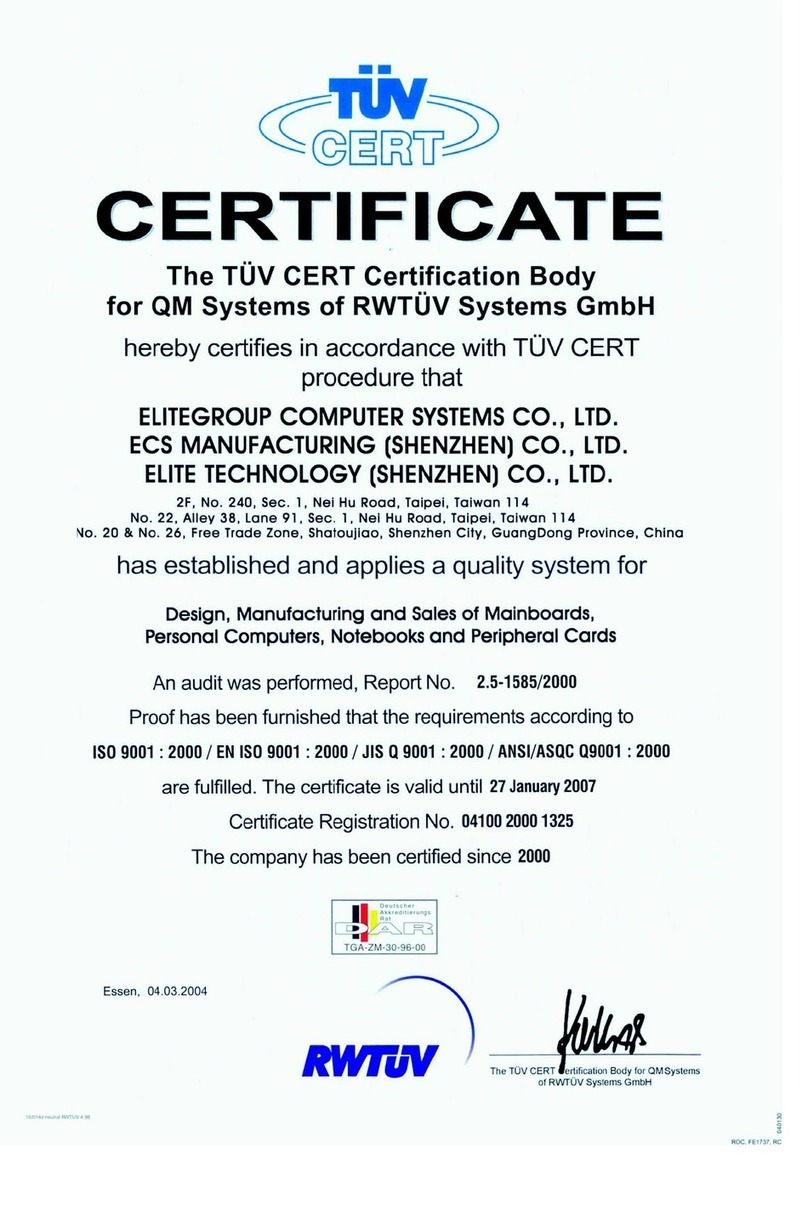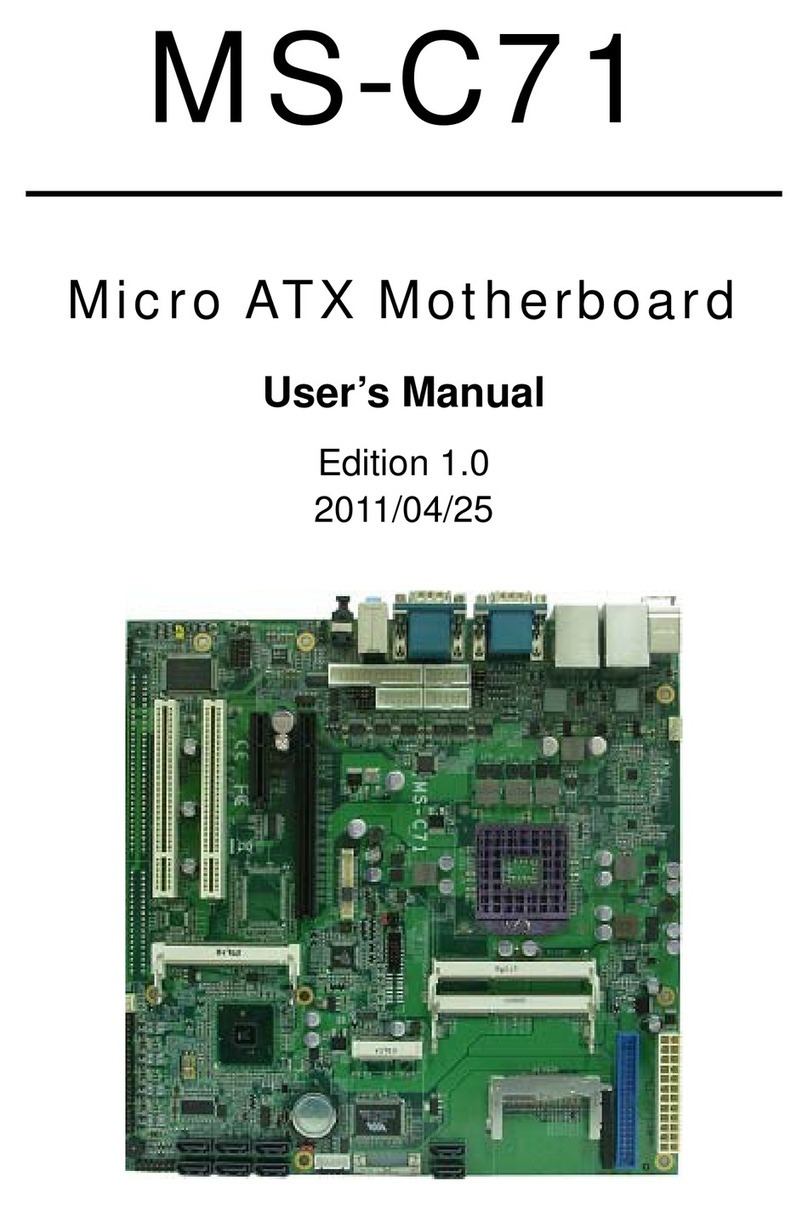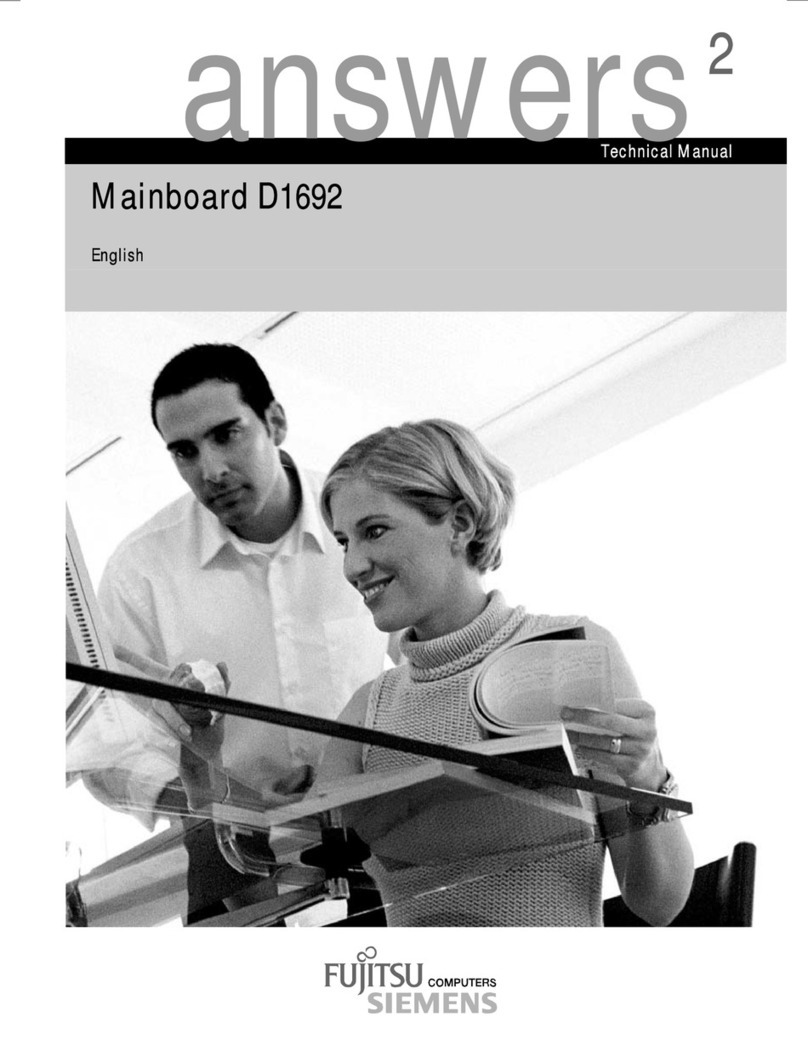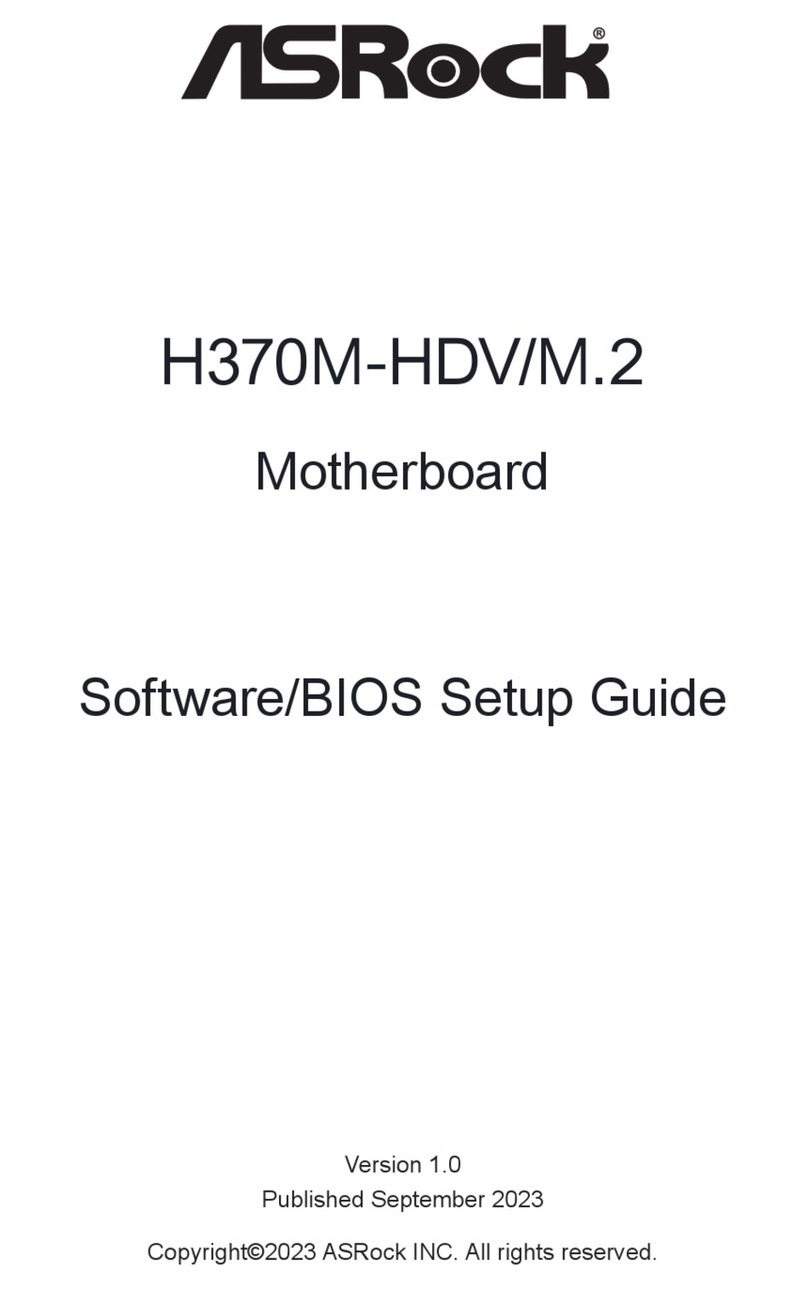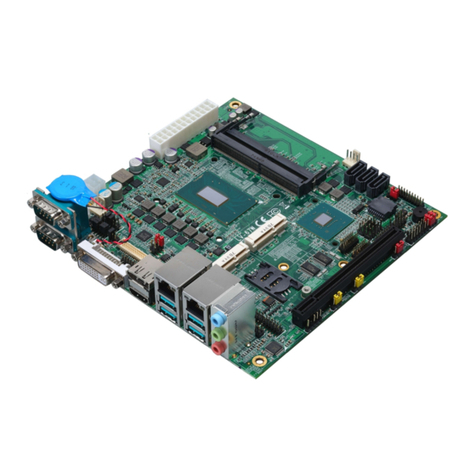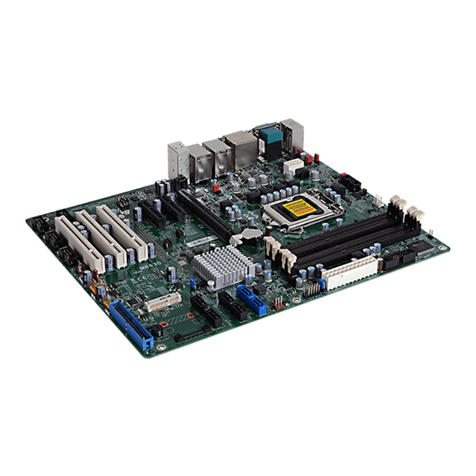Infinion TLD5542-1HIPOW EVAL User manual

User manual Please read the Important Notice and Warnings at the end of this document Rev.1.0
www.infineon.com page 1 of 19 2021-03-04
TLD5542-1HIPOW_EVAL board
Evaluation board manual
About this document
Scope and purpose
The scope of this user manual is to provide instructions on the use of the TLD5542-1HIPOW-EVAL evaluation
board.
TLD5542-1HIPOW_EVAL board is a 4-switch synchronous buck-boost regulator that demonstrates the high-
power capability of the TLD5542-1. The output is adjustable from 5 V to 24 V and the maximum output current is
25 A for up to 300 W power delivery without heatsink.
The switching frequency is 250 kHz and efficiency can go up to 98%.
The board can be configured as current regulator or voltage regulator.
Figure 1 TLD5542-1HI_POW_EVAL device board
Intended audience
Hardware engineers, software engineers, system architects

User manual 2 of 19 Rev.1.0
2021-03-04
TLD5542-1HIPOW_EVAL board
Evaluation board manual
Description
Table of contents
About this document......................................................................................................................... 1
Table of contents .............................................................................................................................. 2
1Description .............................................................................................................................. 3
2Quick start procedure............................................................................................................... 4
2.1 Setup as current regulator with no microcontroller..............................................................................4
2.2 Board set up as voltage regulator with no microcontroller nor PC GUI................................................6
2.3 Board set up as voltage/current regulator with PC GUI.........................................................................7
3Infineon μIO stick and Infineon Toolbox ..................................................................................... 9
3.1 Install and launch Config Wizard ..........................................................................................................10
4Board control with PC GUI........................................................................................................11
4.1 Basic user interface ...............................................................................................................................11
4.2 Engineering user interface....................................................................................................................12
5Operating range and power derating ........................................................................................14
6Electrical characteristics..........................................................................................................15
7Bill of material, PCB layout and schematic.................................................................................16
8List of references.....................................................................................................................17
Revision history...............................................................................................................................18

User manual 3 of 19 Rev.1.0
2021-03-04
TLD5542-1HIPOW_EVAL board
Evaluation board manual
Description
1Description
The H-bridge architecture is amongst the most efficient buck-boost topologies for high current applications. The
TLD5542-1 provides complete control and diagnostics through the SPI interface. The TLD5542-1 can also be used
in applications without microcontroller because of the limp home mode.
The TLD5542-1HIPOW_EVAL demonstrates the high-power capability of the TLD5542-1 as current or voltage
regulator.
The default configuration is adjustable voltage regulator with 25 A maximum output current. By reconfiguring
few solder jumps, the board becomes a current regulator for battery or supercapacitors charger applications.
The board can be controlled by the PC GUI via the Infineon µIO stick (see Chapter 4).
Figure 2 TLD5542-1 as battery charger
Figure 3 TLD5542-1 as voltage regulator
There are 2 trimmers, RVOLT and RSET, to easily adjust output voltage and output current in the entire range
(see table 6).

User manual 4 of 19 Rev.1.0
2021-03-04
TLD5542-1HIPOW_EVAL board
Evaluation board manual
Quick start procedure
2Quick start procedure
Below, step by step procedures are laid out for setup and running the TLD5542-1HIPOW_EVAL in all available
configurations.
Installation procedure for PC GUI (graphical user interface) and μIO stick interface is described in Chapter 4.
2.1 Setup as current regulator with no microcontroller
Setup of the board as simple current regulator, without a microcontroller connection and without µIO stick nor
PC GUI.
The device is configured in limp home. All the registers are set to their default value and the analog dimming is
provided by the voltage on the SET pin which is adjustable with RSET trimmer.
Table 1 Jumper reference and setup for current regulator
Jumper reference
Status
Description
JV1
OPEN
Bypass output current shunt resistor
JV2
OPEN
Disconnect voltage regulator feedback voltage divider
JI1
CLOSE
Connect current shunt
JVDD
CLOSE
Connect Internal 5V IVCC to VDD
J1
CLOSE
Bypass input current shunt resistor
In order to run the board in this configuration
1. Configure solder jumper for LED driver configuration as in Figure 4
2. Connect LHI (limp home) and J_PWMI jumpers
Figure 4 Jumpers to be set for current regulator mode no µC

User manual 5 of 19 Rev.1.0
2021-03-04
TLD5542-1HIPOW_EVAL board
Evaluation board manual
Quick start procedure
3. Connect the load (Note that the output current can be as high as 30 A if SET is adjusted to maximum)
4. Connect a 12 V power supply to the VIN connector
5. Rotate RSET trimmer completely anti-clockwise to lower the output current to the minimum
6. Connect the EN jumper to start providing output current to the load
7. Adjust IOUT with RSET (output current should be higher than 2 A for better transient response)
Figure 5 Connect power supply and load, adjust output current
Warning:
1. If the load is a battery or a supercapacitor, do not use PWMI to stop output current, use EN instead.
Otherwise, the device will affect a startup without soft-start assistance sinking high current from
the charging battery at the VOUT connector.
2. The board is not reverse protected at the input nor at the output, if a battery is connected with
reverse polarity the board or the battery may catch fire.
Correct start-up sequence, to provide current at the load is:
•Set EN to ON with PWMI kept to OFF (blue LED on the PCB turns ON)
•Set desired analog dimming level by using SET pin if limp home mode, otherwise operate via SPI
•Set PWMI to ON

User manual 6 of 19 Rev.1.0
2021-03-04
TLD5542-1HIPOW_EVAL board
Evaluation board manual
Quick start procedure
2.2 Board set up as voltage regulator with no microcontroller nor PC GUI
The following describes how to setup the board as a simple voltage regulator without PC GUI. No
microcontroller connection and no µIO stick is present.
Table 2 Jumper reference and setup for voltage regulator
Jumper reference
Status
Description
JV1
CLOSE
Bypass output current shunt resistor
JV2
CLOSE
Connect voltage regulator feedback voltage divider
JI1
OPEN
Disconnect current shunt from FBL
JVDD
CLOSE
Connect Internal 5V IVCC to VDD
J1
CLOSE
Bypass input current shunt resistor
1. Configure all solder jumpers as shown in Figure 6
2. Connect J_EN, LHI and PWMI jumpers
Figure 6 Jumpers to be set for voltage regulator mode no µC
3. Connect a 12 V power supply to the VIN connector
4. Rotate RSET trimmer completely clockwise (100% analog dim, improves transient response and accuracy)

User manual 7 of 19 Rev.1.0
2021-03-04
TLD5542-1HIPOW_EVAL board
Evaluation board manual
Quick start procedure
Figure 7 Connect power supply, turn RSET to maximum and adjust VOUT with RVOLT
5. Rotate RVOLT trimmer to obtain the desired VOUT
6. Connect the load to VOUT
2.3 Board set up as voltage/current regulator with PC GUI
The TLD5542-1 HIPOW_EVAL can be controlled by the PC GUI via a µIO stick. All the plug jumpers have to be
removed, or the µIO will not be able to control the TLD5542-1 properly.
1. Set solder jumpers for voltage (Chapter 2.1) or current (Chapter 2.2) regualtor
2. Remove jumper plugs J_LHI, J_PWMI, J_EN
Figure 8 Control with μIO stick board preparation

User manual 8 of 19 Rev.1.0
2021-03-04
TLD5542-1HIPOW_EVAL board
Evaluation board manual
Quick start procedure
3. Connect the μIO to J_uIO connector (pin 1 mark on PCB on RED cable strip) and uIO stick to the PC
Figure 9 Connect μIO stick, power supply, load
4. Launch Infineon Toolbox and the Config Wizard for LED, see chapter 3.1
5. Connect power supply to the VIN connector
6. Adjust for the desired output current/voltage with the GUI (see Chapter 4) and connect the load

User manual 9 of 19 Rev.1.0
2021-03-04
TLD5542-1HIPOW_EVAL board
Evaluation board manual
Infineon μIO stick and Infineon Toolbox
3Infineon μIO stick and Infineon Toolbox
The Infineon μIO stick is an interface device for controlling Infineon boards/kits during run time
through PC.
•Enables the connection between the evaluation board and USB for SPI programming and monitoring
by using the Config Wizard software, which can be downloaded via the Infineon Toolbox [1]
•Plugs into the evaluation board via a standard 16-pin connector and allows easy interface to the
microcontroller via USB for SPI, CAN and LIN communication
Figure 10 Infineon μIO stick
The Infineon Toolbox it is a single platform interface which allows for:
•Quick installation of tools by name or QR code
•Help with documentation
•Viewing and starting installed tools from built-in launcher
•Receiving update notifications
Figure 11 Infineon Toolbox
For details about Infineon toolbox and μIO stick check the Infineon website: Infineon Toolbox.

User manual 10 of 19 Rev.1.0
2021-03-04
TLD5542-1HIPOW_EVAL board
Evaluation board manual
Infineon μIO stick and Infineon Toolbox
3.1 Install and launch Config Wizard
1. Open the “Manage tools” tab
2. Search for “Config Wizard for LED” and click on “Install” button
Figure 12 Install Config Wizard for LED
3. Select “My Tools” tab on Infineon Toolbox
4. Press “Start” on the config wizard for LED to start
Figure 13 Start Config Wizard tool
5. Click on TLD5542-1 icon to start the LED GUI interface
Figure 14 Launch TLD5542-1 GUI

User manual 11 of 19 Rev.1.0
2021-03-04
TLD5542-1HIPOW_EVAL board
Evaluation board manual
Board control with PC GUI
4Board control with PC GUI
The TLD5542-1 PC GUI consists of 2 interfaces:
•Basic user interface
•Engineering user interface
The GUI works only if the TLD5542-1 evaluation board is correctly connected to the μIO stick and power supply
is applied to the VIN connector.
4.1 Basic user interface
Basic user interface allows simplified access to the main registers on TLD5542-1 (e.g. analog dimming with a
knob) and provides direct feedback on TLD5542-1 status, showing indicators for each standard diagnosis
register bit.
It is possible to provide EN signal and PWMI without the need for a function generator.
In order to turn on the device press the EN button, the “Active” indicator shall turn on.
Only once the device is on, the desired analog dimming value can be set by the ”Analog Dimming” knob on the
“Dimming” tab.
Correct startup sequence is:
•Have a power supply connected at VIN
•Set EN to ON with PWMI kept to OFF (blue LED on the PCB turns ON)
•Set desired analog dimming level (RSET trimmer if limp home mode otherwise via GUI)
•Set PWMI to ON
Figure 15 TLD5542-1 GUI –Basic user interface
On the “Diagnosis/Monitoring” tab, (see Figure 15) the standard diagnosis register is provided, showing
information on the working status of the device.

User manual 12 of 19 Rev.1.0
2021-03-04
TLD5542-1HIPOW_EVAL board
Evaluation board manual
Board control with PC GUI
On the “Compensation Setting” tab (see Figure 16 ), it is possible to tune the compensation transfer function in
order to have the smoothest transition from buck-boost to boost mode, which depends on the switching
frequency (385 kHz for the TLD5542-1 HIPOW _EVAL board)
Figure 16 TLD5542-1 GUI basic user interface –compensation and EMC tabs
4.2 Engineering user interface
The engineering user interface allows the user to send a sequence of SPI commands to the TLD5542-1. PWMI
and EN pin control is also possible on this interface.
The suggested sequence of operations in order to send the SPI commands is as follows:
1. Write the list of SPI commands that has to be sent
2. Turn on the device by pressing the EN button
3. Press the SEND button to send commands on the list, starting from the black row in the list Figure 17
4. Enable the switching activity by pressing PWMI button
Figure 17 TLD5542-1 GUI –Engineering user interface

User manual 13 of 19 Rev.1.0
2021-03-04
TLD5542-1HIPOW_EVAL board
Evaluation board manual
Board control with PC GUI
It is possible to describe each command with a comment and to save the list of commands by clicking on the
“Save” button.
It is possible to set the delay applied before executing the next command in the “Delay” column, the accuracy
of the timer is approximately 10 ms.
Figure 18 TLD5542-1 GUI –writing comment - saving command list - delay between commands

User manual 14 of 19 Rev.1.0
2021-03-04
TLD5542-1HIPOW_EVAL board
Evaluation board manual
Operating range and power derating
5Operating range and power derating
The TLD5542-1HIPOW-EVAL has very high efficiency, so it can deliver up to 300 W at the output without a
heatsink at TA= 25°C, for VIN down to 9 V.
Figure 19 Thermal acquisition, voltage REG, VIN = 12 V, VOUT = 12 V, IOUT = 25 A, TA= 25°C no heatsink
Please note that the module does not implement thermal protection, so ensure proper cooling when output
power exceeds the power-derating curve. The heatsink must be positioned below the switching MOSFETs as
shown in Figure 20.
Figure 20 Optional heatsink placement
The heatsink shall be electrically insulated from the PCB, by means of a thermal pad.

User manual 15 of 19 Rev.1.0
2021-03-04
TLD5542-1HIPOW_EVAL board
Evaluation board manual
Electrical characteristics
6Electrical characteristics
Table 3 TLD5542-1 HIPOW -EVAL version S03 P01 –electrical characteristics
Parameter
Symbol
Value
Unit
Note/Test Condition
Min.
Typ.
Max.
Input voltage
VIN
7.5
–
35
V
Power derating may occur for VIN < 9 V
Output voltage
VOUT
2
5
–
24
24
V
Current regulator mode
Voltage regulator mode
Output current
IOUT
0
–
25
A
Output power
POUT
-
300
400
–
W
W
No heatsink VIN 9 V to 35 V, TA= 25°C
With heatsink VIN 9 V to 35 V, TA= 25°C
Switching
frequency
Switching
frequency
–
250
–
kHz
Spread spectrum deviation is present
PWM frequency
PWMfreq
100
–
500
Hz
–
System
efficiency
η
–
97
96
–
%
Voltage mode: VIN = 12 V VOUT = 12 V IOUT = 25 A
Current mode: VIN = 12 V VOUT = 12 V IOUT = 20 A

User manual 16 of 19 Rev.1.0
2021-03-04
TLD5542-1HIPOW_EVAL board
Evaluation board manual
Bill of material, PCB layout and schematic
7Bill of material, PCB layout and schematic
Table 4 Bill of material
Designator
Value
Footprint
Quantity
C1, C5, C9, C19, C20, C27, C28, C29
10µF 50V X7R 1210
C1210
8
C2, C6, C7, C8, C10, C11, C13, C22
22µF 25V X7R 1210
C1210
8
C4, C69, CSST
22nF 50V
C0603
3
C12, C14, C24, C25
470µF 25V PCR1E471MCL1GS
CE D10 CASE G
4
C16, C17, C18, C21
330µF 35V PCR1V331MCL1GS
CE D10 CASE G
4
C26, C55, CEN
1µF 50V 0805
C0805
3
C56, CBS1, CBS2
100nF 50V
C0603
3
CC1
33nF 25V
C0603
1
CIVCC
10µF 6,3V 0805 X7R
C0805
1
CMP, CSN, EN, EOMFS, GND, GND3, GND4,
GND5, IINM, IOUTM, LEDC, LHI, MISO, MOSI,
PWMI, SCLK, SET, SST, VDD, VIN, VOUT
Mill-Max 2501-2-00-80-00-00-
07-0
–
21
D2, D3, D4, DBS1, DBS2
NXP_BAT46WJ
SOD323F
5
GND2, GND-, VIN+, VOUT+
Keystone 575-8
4
IC1
TLD5542-1QV
VQFN48 7X7 P05
1
J_EN, J_LHI, J_PWMI
TSW-102-08-G-S
CON-M-THT-TSW-
102-08-G-S
3
J_uIO
Header 8X2(tyco 5-146254-8)
HDR2X8
1
L1
TDK B82559A5332A024
IND SMD B82559A
1
LED
WURTH 150080BS75000
LED 0805 BLU
1
Q1A, Q1B, Q3A, Q3B
IAUC80N04S6L032
PG-TDSON-8-33
4
Q2A, Q4A, Q4B
IAUC100N04S6L020
PG-TDSON-8-33
3
R1, R9, R17, RC1, RVL, R5, R21
1.5kΩ 1%
R0603
7
RFREQ,R89, R90
47kΩ 1%
R0603
3
R3,R10,R18
4.7kΩ 1%
R0603
3
R4, R7, RG1A, RG1B, RG2A, RG2B, RG3A,
RG3B, RG4A, RG4B
1Ω
R0603
10
R11, R12, R13, R14, R16
150Ω 1%
R0603
5
R2,RVH
24kΩ 1%
R0603
2
RSET, RVOLT
Bourns 3266Y-1-203LF
–
2
RSHO1,RSHO
10mΩ FC4L64R010FER
–
2
RSWCS2,RIIN
1.5mΩ PML100HZPJV1L5
–
2
C3, C15, C67, C68, FBH, FBL, G1, G2, G3, G4,
IVCC, SWN1, SWN2, uIO_AD0, uIO_GP1,
uIO_GP2, uIO_VDD5, VFB, Q2B, R6, R8,
RSWCS1
NOT POPULATED
–
–
Spacer 12mm
Wurth 702935000
–
4


A
B
C
D
E
A
B
C
D
E
12345678
12345678
Capacitors are 0603 X7R 10%
Remarks: if not specified differently
connect exposed pad to GND
Place C67 and RVFBL1 close to IC
CSST 22nF 50V
RFREQ
47k 1%
RVL
1k5 1%
RG1A
1
RG2A1
RG3A 1
RG4B
1
R6
NO_POP
C15
NO_POP
R8
NO_POP
C3
NO_POP CBS1
100nF 50V
CBS2
100nF 50V
CIVCC
10uF 6,3V0805 X7R
VIN
44
IIN2
43
SET
22
EN/INUVLO
41
COMP
19
SOFT_START
38
IIN1
42
PWMI
24
IINMON
39
SYNC
34
IOUTMON
16
FREQ
35
VDD
31
CSN
28
SI
30
SO
27
SCLK
29
VSS
26
AGND
40
IVCC_EXT 47
IVCC 46
BST1 3
BST2 10
HSGD1 2
SWN1 4
LSGD1 6
SWCS 17
SGND 18
PGND1 5
SWN2 9
PGND2 8
LSGD2 7
HSGD2 11
VFB 20
FBH 13
FBL 14
DIM_HALF
36
TEST2
25
LHI
37
FILT
23
N.C. 1
N.C. 12
N.C. 15
VFB_VIN 21
EOMFS
32
LEDCURR
33
N.C.
45
N.C.
48
EP
EP
IC1
TLD5542-1QV
L1
TDKB82559A5332A024
RVH
24k 1%
C1 10uF 50VX7R 1210
DBS1
NXP_BAT46WJ
DBS2
NXP_BAT46WJ
C13 22uF 25VX7R1210
C7 22uF 25VX7R1210
C11 22uF 25VX7R1210
C55
1uF50V0805
C5 10uF 50VX7R 1210
C56
100nF 50V
C67
NO_POP120pF 25V
GND
GND
GND
GND
GND
GND
GND
GND GND
GND
GND
GND
GND
VIN
GND
GND
VCCINT
VCCINT
VCCINT
GND GND
GND
GND
GND
SCLK
MOSI
MISO
CSN
PWM_uIO
GND
30A@
30A@
30A@
diff.
diff.
GND
Date: 01/03/2021 Sheet: 1/1
REV:
TITLE: TLD5542-1HIPOW_EVAL
Document Number: S03
GND
C68
NO_POP220pF 50V
BST1
BST2
GND
Place C68 close to IC
D3
NXP_BAT46WJ
D4
NXP_BAT46WJ
CSN
MOSI
MISO
SCLK
Resistors are 0603 5%
REVISION HISTORYFROM S02 to HIGH POW S03
changed Q1Ato Q4B MOS
Changed R5 to 1k5
Changed Default Jumpers to VREG
R89
47k 1%
R90
47k 1%
C69
22nF50V
GND
Vin
R4
1
GND
VCCINT
VCCINT
VHB
VDD
21
JV1
CLOSE
R17
1k5 1%
C4
22nF50V
GND
R2
24k1%
SET
1 2
3 4
5 6
7 8
9 10
11 12
13 14
15 16
J_uIO
Header 8X2(tyco 5-146254-8)
PWM_uIO
SCLK
CSN
MOSI
MISO
EN_uIO
VDD
VDD
30A@
R10
4k71%
D2
NXP_BAT46WJ
EN_uIO
R18
4k7 1%
21
JV2
CLOSE
GND
R3
4k7 1%
VHB
GND
R5
1k5 1%
COMP
VOUT
GND
GND
C24
470uF 25VPCR1E471MCL1GS
VReg->Close
Close=>Vreg
Open=>VReg
GND5
GND
Vout
CMP
EN
PWMI
SCLK
CSN
MISO
MOSI
VDD PWMI
PWMI
CSN
MOSI
MISO
SCLK
EN_INUVLO
VDD
uIO connector
GND
GND
LEDC
EOMFS
EOMFS
LEDCURR
LEDCURR
EOMFS
SPI
IOUTMON
GND
COMP
R11 1501%
R12 1501%
R13 1501%
R14 1501%
VIN+
Keystone 575-8
GND2
Keystone 575-8
VOUT+
Keystone 575-8
GND-
Keystone 575-8
R9
1k5 1%
Q1B
IAUC80N04S6L032
Q3A
IAUC80N04S6L032
Q4A
IAUC100N04S6L020
LHI
1
2
J_LHI
TSW-102-08-G-S
LHI
EN_INUVLO
2 1
JVDD
CLOSE
13
2RVOLT
Bourns 20k 3266Y-1-203LF
1 3
2
20K
RSET
Bourns 20k 3266Y-1-203LF
CC1
33nF 25V RC1
1k5 1%
FB_P
FB_N
VCCINT R1
1k5 1%
VCCINT
VCCINT
GND
VCCINT
IVCC
N.P.
1
2
J_PWMI
TSW-102-08-G-S
1
2
J_EN
TSW-102-08-G-S
uIO_AD0 N.P.
uIO_GP1 N.P.
uIO_GP2 N.P.
G1
N.P.
G2
N.P. SWN1 SWN2
G3
N.P.
G4
N.P.
VFB
N.P.
FBL
N.P.
FBH
N.P.
IOUTM
K A
LED
WURTH 150080BS75000
SST
uIO_VDD5 N.P.
R16
1501%
2 1
JI1
OPEN
VIN
Q2B
NO_POP
Q1A
IAUC80N04S6L032
Q2A
IAUC100N04S6L020 Q3B
IAUC80N04S6L032
Q4B
IAUC100N04S6L020
C20 10uF 50V X7R 1210
C6 22uF 25V X7R 1210
GND
C8 22uF 25V X7R 1210
C10 22uF 25V X7R 1210
GNDGND
C22 22uF25VX7R1210
C2 22uF 25V X7R 1210
GND GND
C12 470uF25VPCR1E471MCL1GS
GND
C14 470uF25VPCR1E471MCL1GS
GND
C25
470uF 25VPCR1E471MCL1GS
IINM
R7
1
C26
1uF50V0805
VIN
C17 330uF35VPCR1V331MCL1GS
GND GND
C18 330uF35VPCR1V331MCL1GS
C29
10uF 50VX7R1210
GND
RIIN
1,5m PML100HZPJV1L5
12
1S
2S
RSWCS1
NO POP
1 2
1S
2S RSWCS2
1,5m PML100HZPJV1L5
RSHO1
10mOhm FC4L64R010FER
GND GND
21
J1
CLOSE
C16
330uF 35VPCR1V331MCL1GS
GND GND
C21
330uF 35VPCR1V331MCL1GS
C9
10uF 50VX7R1210
C27 10uF 50V X7R 1210
C28
10uF 50V X7R 1210
VHB
GNDGND GND
RSHO
10mOhm FC4L64R010FER
+VOUT
GND3
GND4
R21
1k5 1%
RG2B1
RG1B
1
RG4A
1
RG3B1
CEN
1uF 50V0805
GND
C19 10uF 50V X7R 1210
GND
VIN undervoltage set to 7,2V (7,4V Exit)
Close=>IReg
IReg->Open
Open=>IReg
PIC101
PIC102
COC1
PIC201
PIC202
COC2
PIC301
PIC302
COC3
PIC401
PIC402
COC4
PIC501
PIC502
COC5
PIC601
PIC602
COC6
PIC701
PIC702
COC7
PIC801
PIC802
COC8
PIC901
PIC902
COC9
PIC1001
PIC1002
COC10
PIC1101
PIC1102
COC11
PIC1201
PIC1202
COC12
PIC1301
PIC1302
COC13
PIC1401
PIC1402
COC14
PIC1501
PIC1502
COC15
PIC1601
PIC1602
COC16
PIC1701
PIC1702
COC17
PIC1801
PIC1802
COC18
PIC1901
PIC1902
COC19
PIC2001
PIC2002
COC20
PIC2101
PIC2102
COC21
PIC2201
PIC2202
COC22
PIC2401
PIC2402
COC24
PIC2501
PIC2502
COC25
PIC2601 PIC2602
COC26
PIC2701
PIC2702
COC27
PIC2801
PIC2802
COC28
PIC2901
PIC2902
COC29
PIC5501
PIC5502
COC55
PIC5601
PIC5602
COC56
PIC6701
PIC6702
COC67
PIC6801
PIC6802
COC68
PIC6901
PIC6902
COC69
PICBS101
PICBS102
COCBS1
PICBS201
PICBS202
COCBS2
PICC101
PICC102
COCC1
PICEN01
PICEN02
COCEN
PICIVCC01
PICIVCC02
COCIVCC
PICMP01
COCMP
PICSN01
COCSN
PICSST01
PICSST02
COCSST
PID20A PID20K
COD2
PID30A PID30K
COD3
PID40A PID40K
COD4
PIDBS10A
PIDBS10K
CODBS1
PIDBS20A
PIDBS20K
CODBS2
PIEN01
COEN
PIEOMFS01
COEOMFS
PIFBH01
COFBH
PIFBL01
COFBL
PIG101
COG1
PIG201
COG2
PIG301
COG3
PIG401
COG4
PIGND01
COGND
PIGND201
COGND2
PIGND301
COGND3
PIGND401
COGND4
PIGND501
COGND5
PIGND001
COGND0
PIIC101
PIIC102
PIIC103
PIIC104
PIIC105
PIIC106
PIIC107
PIIC108
PIIC109
PIIC1010
PIIC1011
PIIC1012
PIIC1013
PIIC1014
PIIC1015
PIIC1016
PIIC1017
PIIC1018
PIIC1019
PIIC1020
PIIC1021
PIIC1022
PIIC1023
PIIC1024
PIIC1025
PIIC1026
PIIC1027
PIIC1028
PIIC1029
PIIC1030
PIIC1031
PIIC1032 PIIC1033
PIIC1034
PIIC1035
PIIC1036
PIIC1037
PIIC1038
PIIC1039
PIIC1040
PIIC1041
PIIC1042
PIIC1043
PIIC1044
PIIC1045
PIIC1046
PIIC1047
PIIC1048
PIIC10EP
COIC1
PIIINM01
COIINM
PIIOUTM01
COIOUTM
PIIVCC01
COIVCC
PIJ101 PIJ102
COJ1
PIJ0EN01
PIJ0EN02
COJ0EN
PIJ0LHI01
PIJ0LHI02
COJ0LHI
PIJ0PWMI01
PIJ0PWMI02
COJ0PWMI
PIJ0uIO01 PIJ0uIO02
PIJ0uIO03 PIJ0uIO04
PIJ0uIO05 PIJ0uIO06
PIJ0uIO07 PIJ0uIO08
PIJ0uIO09
PIJ0uIO010
PIJ0uIO011 PIJ0uIO012
PIJ0uIO013 PIJ0uIO014
PIJ0uIO015 PIJ0uIO016
COJ0uIO
PIJI101
PIJI102
COJI1
PIJV101
PIJV102
COJV1
PIJV201
PIJV202
COJV2
PIJVDD01
PIJVDD02
COJVDD
PIL101
PIL102
COL1
PILED0A
PILED0K
COLED
PILEDC01
COLEDC
PILHI01
COLHI
PIMISO01
COMISO
PIMOSI01
COMOSI
PIPWMI01
COPWMI
PIQ1A0D
PIQ1A0G
PIQ1A0S
COQ1A
PIQ1B0D
PIQ1B0G
PIQ1B0S
COQ1B
PIQ2A0D
PIQ2A0G
PIQ2A0S
COQ2A
PIQ2B0D
PIQ2B0G
PIQ2B0S
COQ2B
PIQ3A0D
PIQ3A0G
PIQ3A0S
COQ3A
PIQ3B0D
PIQ3B0G
PIQ3B0S
COQ3B
PIQ4A0D
PIQ4A0G
PIQ4A0S
COQ4A
PIQ4B0D
PIQ4B0G
PIQ4B0S
COQ4B
PIR101
PIR102
COR1
PIR201
PIR202
COR2
PIR301
PIR302
COR3
PIR401
PIR402
COR4
PIR501
PIR502
COR5
PIR601
PIR602
COR6
PIR701
PIR702
COR7
PIR801
PIR802
COR8
PIR901
PIR902
COR9
PIR1001
PIR1002
COR10
PIR1101 PIR1102
COR11
PIR1201 PIR1202
COR12
PIR1301 PIR1302
COR13
PIR1401 PIR1402
COR14
PIR1601
PIR1602
COR16
PIR1701
PIR1702
COR17
PIR1801
PIR1802
COR18
PIR2101
PIR2102
COR21
PIR8901
PIR8902
COR89
PIR9001
PIR9002
COR90
PIRC101
PIRC102
CORC1
PIRFREQ01
PIRFREQ02
CORFREQ
PIRG1A01 PIRG1A02
CORG1A
PIRG1B01 PIRG1B02
CORG1B
PIRG2A01 PIRG2A02
CORG2A
PIRG2B01 PIRG2B02
CORG2B
PIRG3A01
PIRG3A02
CORG3A
PIRG3B01
PIRG3B02
CORG3B
PIRG4A01
PIRG4A02
CORG4A
PIRG4B01
PIRG4B02
CORG4B
PIRIIN01
PIRIIN01S
PIRIIN02
PIRIIN02S
CORIIN
PIRSET01
PIRSET02
PIRSET03
CORSET
PIRSHO01
PIRSHO01S
PIRSHO02
PIRSHO02S
CORSHO
PIRSHO101
PIRSHO101S
PIRSHO102
PIRSHO102S
CORSHO1
PIRSWCS101
PIRSWCS101S
PIRSWCS102
PIRSWCS102S
CORSWCS1
PIRSWCS201
PIRSWCS201S
PIRSWCS202
PIRSWCS202S
CORSWCS2
PIRVH01 PIRVH02
CORVH
PIRVL01
PIRVL02
CORVL
PIRVOLT01
PIRVOLT02
PIRVOLT03
CORVOLT
PISCLK01
COSCLK
PISET01
COSET
PISST01
COSST
PISWN101
COSWN1
PISWN201
COSWN2
PIuIO0AD001
COuIO0AD0
PIuIO0GP101
COuIO0GP1
PIuIO0GP201
COuIO0GP2
PIuIO0VDD501
COuIO0VDD5
PIVDD01
COVDD
PIVFB01
COVFB
PIVIN01
COVIN
PIVIN001
COVIN0
PIVOUT01
COVOUT
PIVOUT001
COVOUT0
PIC2202
PIJV102
PIRSHO02
PIRSHO101
PIVOUT01
PIVOUT001
NL0VOUT
PICBS102
PIDBS10K
PIIC103
NLBST1
PICBS202
PIDBS20K
PIIC1010
NLBST2
PICMP01
PIIC1019
PIRC102
NLCOMP
PICSN01
PIJ0uIO09
PIR1101
NLCSN
POCSN
PICEN02
PID20K
PIEN01
PIIC1041
PIR301
PIR502
NLEN0INUVLO
PIEOMFS01
PIIC1032
PIR8901
NLEOMFS
PIFBL01
PIIC1014
PIJI102
PIR1602
PIR1702
PIRVOLT01
NLFB0N
PIFBH01
PIIC1013
PIR1601
PIRSHO01S
PIRSHO102S
PIRVH02
NLFB0P
PIC101
PIC201
PIC301
PIC401
PIC501
PIC601
PIC701
PIC801
PIC901
PIC1001
PIC1101
PIC1202
PIC1301
PIC1402
PIC1501
PIC1602
PIC1702
PIC1802
PIC1901
PIC2001
PIC2102
PIC2201
PIC2402 PIC2502
PIC2701 PIC2801
PIC2901
PIC5501
PIC5601
PIC6701
PIC6801
PIC6901
PICC102
PICEN01
PICIVCC02
PICSST01
PIGND01
PIGND201
PIGND301
PIGND401
PIGND501
PIGND001
PIIC101
PIIC105
PIIC108
PIIC1012
PIIC1015
PIIC1026
PIIC1034
PIIC1036
PIIC1040
PIIC1045 PIIC1048
PIIC10EP
PIJ0uIO02
PIJV201
PIR501
PIR1002
PIR2101
PIRFREQ01
PIRSET01
PIRSWCS102 PIRSWCS201
PIRVL01
PIC6902
PIIC1016
PIIOUTM01
NLIOUTMON
PIIC1033
PILEDC01
PIR9002
NLLEDCURR
PIIC1037
PILHI01
PIR102
NLLHI
PIJ0uIO013
PIMISO01
PIR1301
NLMISO
POMISO
PIJ0uIO015
PIMOSI01
PIR1201
NLMOSI
POMOSI
PIC202 PIC602
PIC702
PIC802
PIC1002
PIC1102
PIC1201
PIC1302
PIC1401
PIC2401 PIC2501
PIJV101
PIQ4A0D
PIQ4B0D
PIRSHO01
PIRSHO102
PIC302
PIR801
PIC402
PIR1701
PIC1502
PIR601
PIC2601
PIIC1042
PIR402
PIC2602
PIIC1043
PIR701
PIC6702
PIIC1020
PIRVH01
PIRVL02
PIVFB01
PIC6802
PIIC1023
PICBS101
PIIC104
PIL102
PIQ1A0S
PIQ1B0S
PIQ2A0D
PIQ2B0D
PIR802
PISWN101
PICBS201
PIIC109
PIL101
PIQ3A0D
PIQ3B0D
PIQ4A0S
PIQ4B0S
PIR602
PISWN201
PICC101
PIRC101
PICSST02
PIIC1038
PISST01
PID20A
PIJ0uIO08
POEN0uIO
PID30A
PIJ0uIO014
POPWM0uIO
PID30K
PID40K
PIR901
PIR1001
PID40A
PIJ0PWMI02
PIG101
PIQ1A0G
PIRG1A02
PIG201
PIQ2A0G
PIRG2A02
PIG301
PIQ3B0G
PIRG3B02
PIG401
PIQ4B0G
PIRG4B02
PIIC102
PIRG1A01
PIRG1B01
PIIC106
PIRG2A01
PIRG2B01
PIIC107
PIRG3A01
PIRG3B01
PIIC1011
PIRG4A01
PIRG4B01
PIIC1017
PIRSWCS101S PIRSWCS202S
PIIC1018
PIRSWCS102S PIRSWCS201S
PIIC1022
PIRSET02
PISET01
PIIC1027
PIR1302
PIIC1028
PIR1102
PIIC1029
PIR1402
PIIC1030
PIR1202
PIIC1035
PIRFREQ02
PIIC1039
PIIINM01
PIJ0EN02
PIR302
PIJ0LHI01
PIR101
PIJ0uIO01
PIJ0uIO03 PIJ0uIO04
PIuIO0VDD501
PIJ0uIO05 PIJ0uIO06
PIJ0uIO07
PIJ0uIO010
PIuIO0GP201
PIJ0uIO012
PIuIO0GP101
PIJ0uIO016
PIuIO0AD001
PIJI101
PIRSHO02S
PIRSHO101S
PIJV202
PIR1801
PILED0K
PIR2102
PIQ1B0G
PIRG1B02
PIQ2A0S
PIQ2B0S
PIQ3A0S
PIQ3B0S
PIRSWCS101 PIRSWCS202
PIQ2B0G
PIRG2B02
PIQ3A0G
PIRG3A02
PIQ4A0G
PIRG4A02
PIR201
PIRSET03
PIR401
PIRIIN01S
PIR702
PIRIIN02S
PIR1802
PIRVOLT02
PIRVOLT03
PIIC1024
PIPWMI01
PIR902
NLPWMI
PIJ0uIO011
PIR1401
PISCLK01
NLSCLK
POSCLK
PICIVCC01
PIDBS10A
PIDBS20A
PIIC1021
PIIC1025
PIIC1046
PIIC1047
PIIVCC01
PIJ0LHI02
PIJ0PWMI01
PIJVDD01
PILED0A
PIR202
PIC5602
PIIC1031
PIJVDD02
PIR8902
PIR9001
PIVDD01
PIC102 PIC502
PIC902
PIC1601
PIC1701
PIC1801
PIC1902
PIC2002
PIC2101
PIC2702 PIC2802
PIC5502
PIIC1044
PIJ102
PIJ0EN01
PIQ1A0D
PIQ1B0D
PIRIIN02
PIC2902
PIJ101
PIRIIN01
PIVIN01
PIVIN001
POCSN
POEN0uIO
POMISO
POMOSI
POPWM0uIO
POSCLK

User manual 18 of 19 Rev.1.0
2021-03-04
TLD5542-1HIPOW_EVAL board
Evaluation board manual
List of references
Revision history
Document
version
Date of release
Description of changes
Rev.1.0
2021-03-04
Initial User Manual
Table of contents
Other Infinion Motherboard manuals


